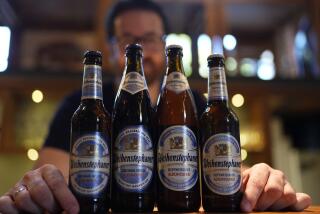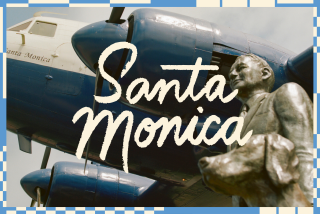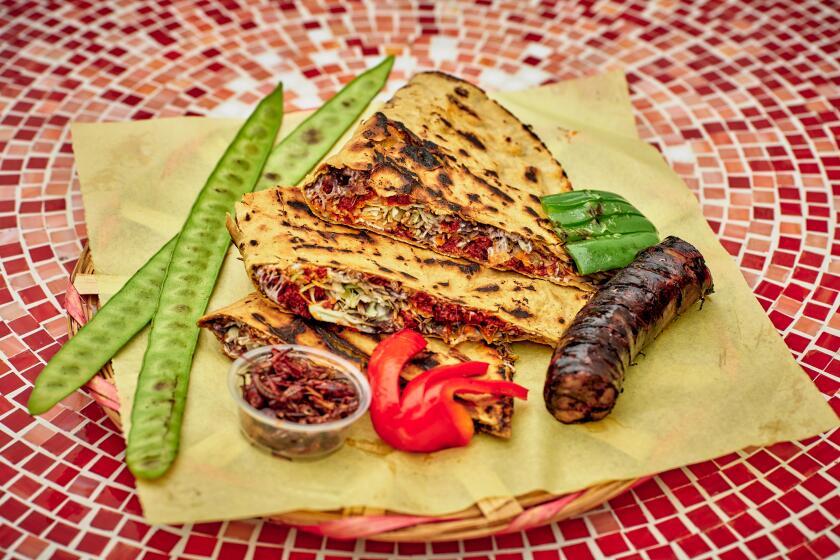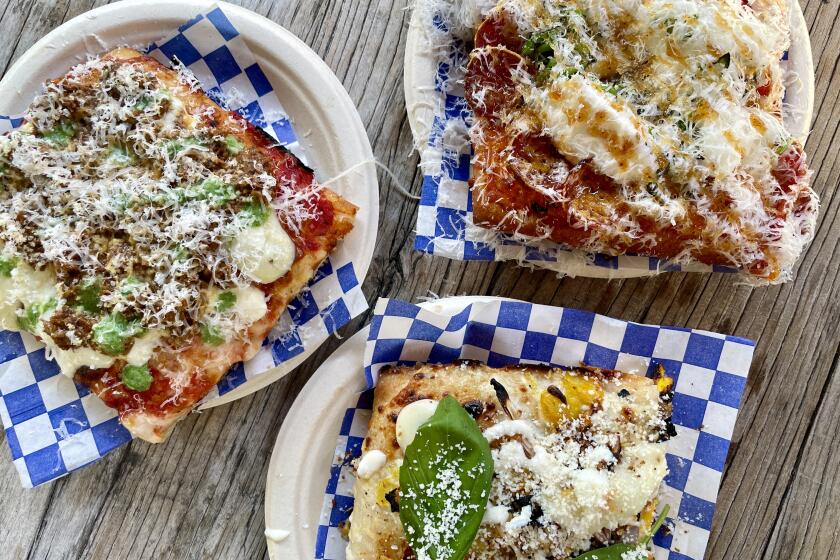Store beer in a wine-like cave? Southern California gives it a try
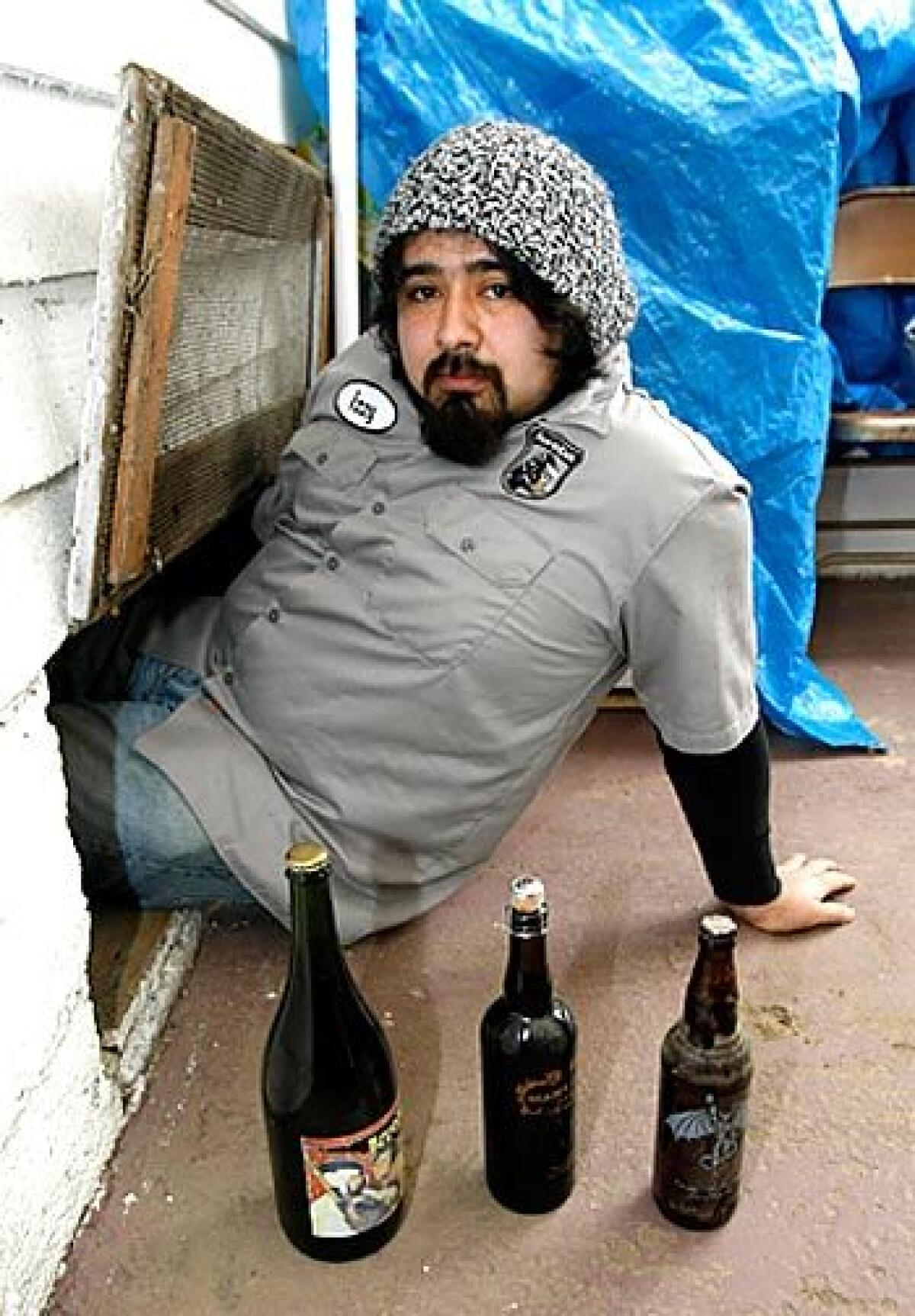
To grab a beer, Israel Arrieta doesn’t just stroll to the fridge; he has to walk out his back door to the side of the house, where he pries a chicken-wire screen off a basement window and scrambles, crab position, down a wooden ladder.
Several minutes later, he emerges cradling half a dozen cool, dusty bottles of beer.
Arrieta, 27, keeps his beer in the closest thing to a cave: the crawl space under his parents’ North Pasadena house. To test it out years ago, he crawled down on a 100-degree afternoon holding a thermometer. It read 60 degrees.
“Light and temperature are going to be your enemies,” Arrieta says. “But your worst enemy is going to be yourself. That’s why it’s under there.”
Arrieta cellars his beer — stouts, porters and strong ales that he says get better over the years, even decades. He ransacks the cellar only twice a year.
Though cellaring beer has nowhere near the following that cellaring wine does, hundreds of beer fans in Southern California have begun amassing impressive collections of beers made to mature.
Turning basements, garages and bedroom closets into beer caves is the latest twist in L.A.’s growing beer culture — one that increasingly revolves around collecting, trading and, yes, waiting, with patience once ascribed only to wine drinkers. Some of the collections cost several thousand dollars too.
This year alone, dozens of California brewers will release specialty beers that crank up the alcohol percentage and punch up the spices (everything from figs to juniper berries) to create flavors that age. Many sit for months in the same oak casks used for whiskey, wine or brandy, earning followings among even Scotch drinkers. Brands with names such as Decadence, Old Stock, Angel’s Share and Consecration hit the market in small batches, only to be snatched up for private collections, as if they were Impressionist art.
Stone Brewing Co. in Escondido may brew the best-known, a series of annual beers called Vertical Epic, with each new release coming one year, one month and one day after the last. The full flight is meant to be experienced, according to the brewers, in one sitting on Dec. 12, 2012.
Even Trader Joe’s has gotten in on the act. The U.S. chain has contracted with well-respected Canadian brewery Unibroue since 2005 to make its Vintage Ale, the beer equivalent of its Two-Buck Chuck (it’s $4.99 a bottle).
Keeping beer in cellars has, of course, been done for centuries by Trappist monks and Europe’s most serious taverns. Even in the U.S., traditional brewers have long used underground storage to “lager” their brews for months.
But aging beer for personal consumption is relatively new in the U.S. and particularly in Southern California, where basements, let alone caves, are hard to come by.
Tomm Carroll keeps 500 beers locked in a cement closet in the underground parking garage of his Culver City condo. The 55-year-old, who writes for the film industry, estimates he has spent $10,000 on his collection, which shares space with his neighbors’ deflated mountain bikes and beach chairs. Some of the rare specimens that date back to the ‘80s could fetch more than $100 a bottle on EBay.
He has an additional 200 bottles in the kitchen cupboard where his wife used to keep their oil and vinegar. This year he started renting a temperature-controlled wine locker to handle the overflow.
The Carrolls like to age Sierra Nevada Brewing Co.’s Bigfoot Ale, a hoppy, barley-wine-style beer that evolves over time thanks to its 11% alcohol. Carroll can tell you that Bigfoot Ale “peaks” at about 5 years old if it’s matured properly in a dry, dark space kept around 55 degrees.
“After that it doesn’t mean it’s not any good, it’s just not as good,” Carroll says.
He only knows because he keeps a log. Carroll says cellaring beer, unlike wine, is an evolving hobby, with collectors still groping around to find the best vintages. “It’s still young, this idea of aging beers.”
Even brewers at Sierra Nevada were clueless at first, according to Bill Sysak. The retired medic known in the beer community as “Dr. Bill” first stashed English ales under the bed when his father caught him drinking in the family’s Garden Grove basement 34 years ago. So, when Sysak had dinner with Sierra Nevada’s founder Ken Grossman in the mid-1990s, he brought vintage bottles of Bigfoot Ale.
“Ken said, ‘Whoa, whoa, these are all supposed to be drunk fresh,’” Sysak recalls. “I like to think that made him realize” his beers could be aged.
Sysak keeps more than 1,000 bottles in a row of glass-door fridges built into his house. But he’s also stashed sour lambic-style beers in his bathroom cabinetand stouts in his bedroom closet.
His all-time favorite aged beer is a British ale called Thomas Hardy’s that can be “laid down” for decades to gain Port, Madeira, sherry and Cognac notes. Sysak has held tastings at which he poured every vintage from 1968 to 2003 in one sitting. “I’ve seen that beer ride a roller coaster,” says Sysak, who now works as beverage coordinator at Stone Brewing Co.
Not all beers get better, especially fizzier, fresher-tasting beers. Forget most lagers and pilsners and pale ales, whose floral hoppiness can drop off, leaving a bitter, watery mess. Beers that age well tend to be strong (at least 6% alcohol), dark in color and heavy on the malted grains, which grow toasty. Collectors also look for unfiltered, bottle-conditioned ales, ones in which the brewer purposefully adds extra yeast at the end to foster fermentation.
Most beer experts are quick to point out all these rules, as well as one caveat: Just because a beer is heavy and dark does not mean it won’t poop out on you. Since the pastime is still young, compared with, say, wine collecting, there’s only one way to learn a beer’s limits, collectors say: Buy a case, treat it right, and drink it often.
Alen Mirzakhanyan, a Raytheon engineer from Glendale, doesn’t have a cellar, so he re-wired two kitchen fridges to keep his beer at 55 degrees and installed beams to support the shelves from buckling under the weight of 400 bottles.
Some of them, such as Cantillon’s Blabaer, made once a year for a cafe in Denmark, are impossible to find except by trading over the Internet with European collectors. But he also takes time off from work to drive down to San Diego’s Port Brewing or the Bruery in Placentia for special releases made for aging. Although the Bruery restricted purchases of its recent barrel-aged stout, Black Tuesday, Mirzakhanyan traded to get a full case so he could watch it change.
“The main point in aging is not just to have beer when it’s old, but to see the progression,” he says. “If you just age all the bottles for 10 years and drink them in a month, that doesn’t make sense.”
The discipline is part of what attracts people such as Arrieta, who sums up his hobby as “not drinking everything just because you have it.”
Scared of hoarding more than he can drink, Arrieta now looks for any special occasion to host tastings. On a recent damp winter night, Arrieta clambered down the ladder with a flashlight. He pawed through cardboard boxes making sure they kept dry on the dirt floor, and dusted off a cobalt bottle of Sam Adams Triple Bock, a maple syrup ale that’s 17% alcohol, bottled in 1997. He grabbed snifters.
The metal cap made no sound lifting off. Sediment caked to the inside of the bottle hinted that the brew might have been past its prime. It was perfectly still, yeasty and sweet, but also cloyingly salty, more like Kikkoman than a Boston lager.
Putting his own glass down after three sips, Arrieta said the beer was more malty than he remembered.
“Don’t feel like you have to drink it all,” he said, moving on to the next bottle.
More to Read
Eat your way across L.A.
Get our weekly Tasting Notes newsletter for reviews, news and more.
You may occasionally receive promotional content from the Los Angeles Times.
